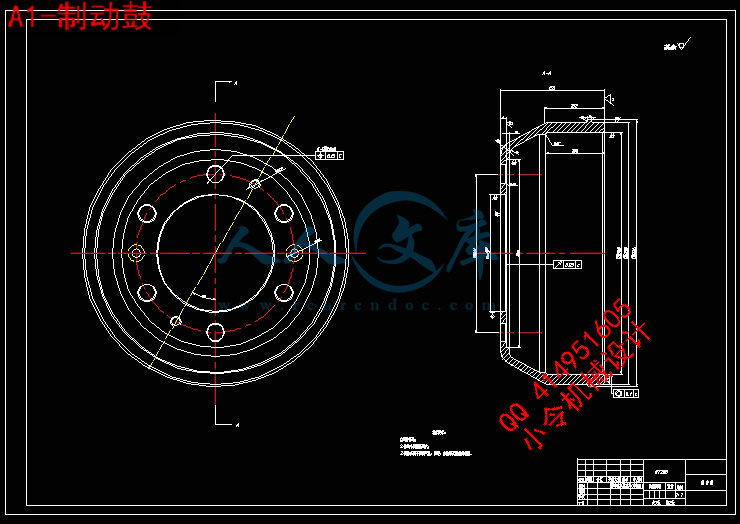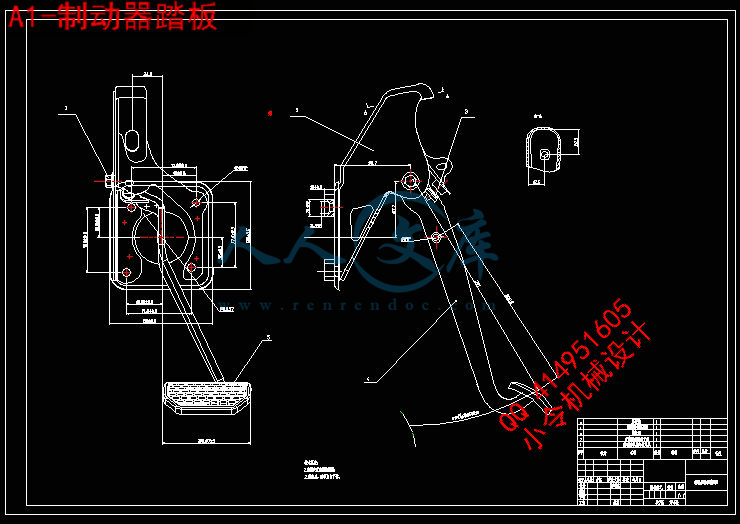【温馨提示】 购买原稿文件请充值后自助下载。
[全部文件] 那张截图中的文件为本资料所有内容,下载后即可获得。
预览截图请勿抄袭,原稿文件完整清晰,无水印,可编辑。
有疑问可以咨询QQ:414951605或1304139763
解放牌中型货车后轮鼓式制动器设计
摘 要
鼓式制动也叫块式制动,现在鼓式制动器的主流是内张式,它的制动蹄位于制动轮内侧,刹车时制动块向外张开,摩擦制动轮的内侧,达到刹车的目的。
制动系统在汽车中有着极为重要的作用,如果失效将会造成灾严重的后果。制动系统的主要部件就是制动器,在现代汽车上仍然广泛使用的是具有较高制动效能的蹄—鼓式制动器。本设计就摩擦式鼓式制动器进行了相关的设计和计算。在设计过程中,以实际产品为基础,根据我国目前进行制动器新产品开发的一般程序,并结合理论设计的要求,首先根据给定车型的整车参数和技术要求,确定制动器的结构形式、制动器主要参数及其选择,然后计算制动器的最大制动力矩、同步附着系数、制动力与制动力分配系数、制动器的结构参数与摩擦系数等,并在此基础上进行制动器主要零部件的结构设计。最后,完成装配图和零件图的绘制。
关键词:鼓式制动器;制动力;最大制动力矩;结构参数;摩擦系数
The design of jiefang medium-sized truck rear wheel drum brake
Abstract
Drum brake, also known as block-type brake, drum brakes, now within the mainstream style sheets, and its brake shoes located inside the brake wheel, brake brake blocks out when open, the inside wheel friction brake, to achieve the purpose of the brakes.
In the vehicle braking system has a very important role, failure will result in disaster if serious consequences. The main parts of the braking system is the brake, in the modern car is still widely used in high performance brake shoe - brake drum. The design of the friction drum brakes were related to the design and calculation. In the design process, based on the actual product, according to our current brake factory general new product development process, and theoretical design requirements, the first model of the vehicle according to the given parameter and the technical requirements, determine the brake structure and, brake main parameters and their choice, and then calculate the maximum braking torque of brake, the synchronous adhesion coefficient and brake force and brake force distribution coefficient, the structural parameters of the brake and friction coefficient, deformation shoe, brake effectiveness factor, braking deceleration, wear characteristics, brake temperature, etc., and in this brake on the basis of the structural design of major components. Finally, assembly drawings and parts to complete mapping.
KeyWords:drumbrake; braking force; maximum braking torque; Structure parameters; the coefficient of friction
目 录
1 绪论 1
1.1汽车制动器发展的概况 1
1.2研究制动器系统的意义 2
1.3制动系应满足的要求 2
1.4本设计要完成的内容 2
2 鼓式制动器的结构形式与选择 3
2.1鼓式制动器的结构形式 4
2.1.1领从蹄式制动器 4
2.1.2双领从蹄式制动器 4
2.1.3双向双领从蹄式制动器 4
2.1.4单项增力式制动器 5
2.1.5双向增力式制动器 5
3 制动器的主要参数及其选择 6
3.1制动力与制动力分配系数 6
3.2同步附着系数的计算 10
3.3制动器最大制动力矩 11
3.4制动器的结构参数与摩擦系数 12
4 制动器的主要零件的结构计算 15
4.1制动鼓 15
4.2制动蹄 15
4.3制动底板 15
4.4支承 16
4.5制动轮缸 16
4.6摩擦材料 16
4.7制动器间隙的调整方法及相应机构 16
4.8液压驱动机构的设计与计算 17
4.9制动器的校核 17
5 结论 19
致 谢 20
参考文献 21
毕业设计(论文)知识产权声明 22
毕业设计(论文)独创性声明 23
附录1 24
附录2 25
1 绪论
1.1汽车制动器发展的概况
从汽车诞生时起,车辆制动系统在车辆的安全方面就扮演者至关重要的角色。近年来,随着车辆技术的进步和汽车行驶速度的提高,这种重要性表现的越来越明显。汽车制动系统种类很多,形式多样。传统的制动系统结构形式主要有机械式、气动式、液压式、气-液混合式。它们的工作原理基本都一样,都是利用制动装置,用工作时产生的摩擦热来逐渐消耗车辆所具有的动能,已达到车辆制动减速,或制止停车的目的。
伴随着节能和清洁能源汽车的研究开发,汽车制动系统发生了很大的变化,出现了很多新的结构形式和功能形式。新型制动力系统的出现也要求制动系统结构形式和功能形式发生相应的改变。例如电动汽车没有内燃机,无法为真空助力器提供真空源,一种解决方案是利用电动真空泵为真空助力器提供真空。汽车制动系统的发展是和汽车性能的提高及汽车结构形式变化密切相关的,制动系统的每个组成部分都发生了很大的变化[1]。
1.2研究制动系统的意义
制动系统是汽车的一个重要组成部分,它直接影响汽车的安全性。随着高速公路的迅速发展和车流密度的日益增大,交通事故也不断增加。据有关资料介绍,在由于车辆本身的问题而造成的交通事故中,制动系统故障引起的事故为总数的45%。可见,制动系统是保证行车安全的极为重要的一个系统。此外,制动系统的好坏还直接影响车辆的平均







 川公网安备: 51019002004831号
川公网安备: 51019002004831号